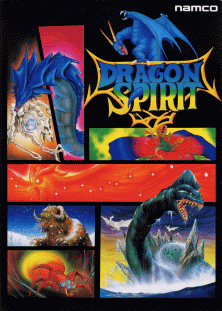Dragon Spirit
| Dragon Spirit | |
|---|---|
 Arcade flyer | |
| Developer(s) | Namco Consult Software Domark The Hit Squad |
| Publisher(s) | |
| Designer(s) | Ojisan Trio Plus 1 |
| Composer(s) | Shinji Hosoe |
| Platform(s) | Arcade, Amiga, Amstrad CPC, Atari ST, Commodore 64, PC Engine/TurboGrafx-16, Wii (Virtual Console), X68000, ZX Spectrum, NES |
| Release | June 20, 1987
|
| Genre(s) | Vertical scrolling shooter |
| Mode(s) | Up to two players, alternating turns |
| Arcade system | Namco System 1 |
Dragon Spirit (ドラゴンスピリット, Doragon Supiritto) is a vertical scrolling shooter arcade game that was released by Namco in 1987 and licensed to Atari Games for its American manufacture and distribution.[1] It runs on Namco System 1 hardware, and was later ported to the Amstrad CPC, Commodore Amiga, Commodore 64, DOS, Atari ST, X68000, PC Engine/TurboGrafx-16 and ZX Spectrum platforms.[1]
Plot
In the kingdom of Mitgult, an ugly serpent demon named Zawell escapes imprisonment after a thousand years, and kidnaps Princess Alicia. A soldier named Amul is chosen to rescue her and destroy Zawell. He points his sword skyward and transforms into a powerful blue dragon. He can breathe fire and drop bombs, as well as collect up to thirteen additional powers during his journey. Amul must fight nine of Zawell's mightiest beasts, one at the end of each stage, before facing Zawell himself.[1][2][3]
Gameplay

Amul always moves forward, but the player can move him in 8 directions.[2] He can blast flames at aerial opponents, or drop bombs on enemies upon the ground.[2][3] Amul has a larger sprite than most of the enemies and so is easy to hit,[4] though he can take two hits before losing a life (three in some ports). The powerups that give the player extra heads may give him double or triple the firepower, but they also give him double or triple the exposure to enemy fire which, especially on the later stages, can become intensely difficult to avoid. As such, beating the game is not easy.[4]
Other releases
A semi-sequel appeared on the Famicom/NES under the title Dragon Spirit: The New Legend. It was essentially an altered port, taking place a generation after the original title. An arcade sequel named Dragon Saber was released in 1990, which ran on Namco System 2 hardware and allowed two players to play simultaneously.[2][5]
Additionally, Dragon Spirit was released for the PC Engine/TurboGrafx-16 in 1988. This version retained most of the original arcade graphics and sound quality, but only featured eight stages as opposed to the arcade version's nine.[2] An emulated arcade version of Dragon Spirit appears in Namco Museum 50th Anniversary and Namco Museum Vol. 5.[1] On July 2, 2007, the PC Engine (or TurboGrafx-16) conversion of the game was added to the Nintendo Virtual Console, and on September 8, 2009, the arcade version was released as part of the Virtual Console Arcade, in Japan. On November 4, 2008, it was released on the Xbox 360, as part of Namco Museum Virtual Arcade.[1] The game was also released on the PlayStation Network as part of a downloadable compilation for the PlayStation 3, Namco Museum Essentials.[1] In 2010, as part of Pac-Man's thirtieth anniversary, Dragon Spirit was released as part of the Pac-Man's Arcade Party 30th Anniversary arcade machine - along with eleven (or twelve, if referring to the home version, which includes the unauthorized title Ms. Pac-Man), other classic Namco games.[6]
See also
References
- ^ a b c d e f Dragon Spirit. (2012, August 18). Arcade History. Retrieved December 4, 2012, from http://www.arcade-history.com/?n=dragon-spirit&page=detail&id=699
- ^ a b c d e Dragon Spirit. (2012, October 3). StrategyWiki. Retrieved December 4, 2012, from http://strategywiki.org/wiki/Dragon_Spirit
- ^ a b Dragon Spirit. (n.d.). Video Game Den. Retrieved December 4, 2012, from http://www.videogameden.com/hucard.htm?dsp
- ^ a b McFerran, D. (2007, July 2). Dragon Spirit review. Nintendolife. Retrieved December 4, 2012, from http://www.nintendolife.com/reviews/2007/07/dragon_spirit_virtual_console
- ^ Dragon Spirit. (n.d.). Moby Games. Retrieved December 4, 2012, from http://www.mobygames.com/game/dragon-spirit
- ^ Pac-Man's arcade party 30th anniversary cocktail arcade - home version. (n.d.). Monkeys Arcades. Retrieved December 4, 2012, from http://www.monkeysarcades.com/Pacman_s_Arcade_Party_30th_Anniversary_Cocktail_p/pac30thct-hv.htm
External links
- Dragon Spirit at the Killer List of Videogames
- Dragon Spirit at the Arcade History database
- Dragon Spirit: The New Legend at MobyGames
- Dragon Spirit Review
- Dragon Spirit at SpectrumComputing.co.uk
- 1987 video games
- Arcade games
- Amiga games
- Amstrad CPC games
- Atari ST games
- Commodore 64 games
- Sharp X68000 games
- TurboGrafx-16 games
- Virtual Console games
- ZX Spectrum games
- Namco arcade games
- Nintendo Entertainment System games
- Atari arcade games
- Vertically scrolling shooters
- Shapeshifting in fiction
- Dragons in video games
- Fantasy video games
